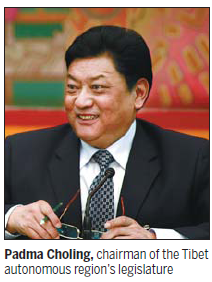Tibet welcomes more visitors from abroad
The Tibet autonomous region will open up further to the outside world and attract more visitors from aboard as of this summer, according to a senior Tibetan legislator.
In 2010, the central government proposed making the region a major global tourism destination, and from January to November last year, it received more than 190,000 overseas tourists, the local tourism bureau said.

"The autonomous region has to further open up to ensure the tourism industry develops in the right direction," said Padma Choling, chairman of the region's legislature.
"Tourism will further open up to the world from this summer," he told China Daily in an exclusive interview on the sidelines of the annual session of the 12th National People's Congress.
He said summer will be the starting point, as conditions in winter are harsh.
Padma Choling said that without further opening-up, the tourism industry won't make any breakthrough and it will be difficult to build Tibet into a global tourism destination.
In 2012, the region attracted 10.58 million visitors, an increase of 21.7 percent year-on-year, generating 12.64 billion yuan ($2 billion) in income.
Tibetan authorities expect the tourism industry's contribution to local GDP to climb to 20 percent by the end of 2015, with the number of overseas tourists expected to account for more than 10 percent of the total, generating more than 15 percent of revenue.
But Padma Choling said the opening-up should abide by State foreign policies first and "fit the local situation".
"The prerequisite of opening-up is to upgrade service facilities and service capabilities to match the requirements. And we have to protect national territory at the borders."
Tibet has a host of tourist attractions, including the highest peak in the world, Qomolangma, known as Mount Everest in the West; the Yarlung Zangbo Grand Canyon; and the Potala Palace.
Given the need to protect the unique lifestyles of ethnic groups, cultural relics and local ecology, foreign tourists must apply for entry permits. In 2010, former foreign ministry spokesman Qin Gang said the region could not cater to all tourists because of restrictions such as natural conditions. As a result, authorities began managing the flow by introducing entry permits, he said.
"Many foreigners, including reporters, have traveled to Tibet for work, tours and interviews. I believe we'll see more foreigners coming to Tibet as the region develops and conditions improve constantly."
The Tibet tourism bureau has set up offices in many places, including Beijing, Shanghai, Hong Kong, the United States and Japan, organizing group tours for foreigners and answering inquires.
The development of tourism has also benefited local people.
In 2012, some 53,000 farmers and herdsmen from 13,000 households operated reception services for tourists.
wanghuazhong@chinadaily.com.cn
- Tibet's 'Three Gorges Dam' to generate power
- China to wrap up Tibet railway extension line
- Tibet vows resolute fight against Dalai clique
- 5.4-magnitude quake jolts Tibet
- Tibet's 'independence day' just a farce
- New Tibet chairman vows further reform
- Tibet's development top priority of China: ambassador
- Tibet aims to double incoming tourists
- Tibet to invest over $563m to protect its environment
- Tibet sees 21% surge in air passengers























